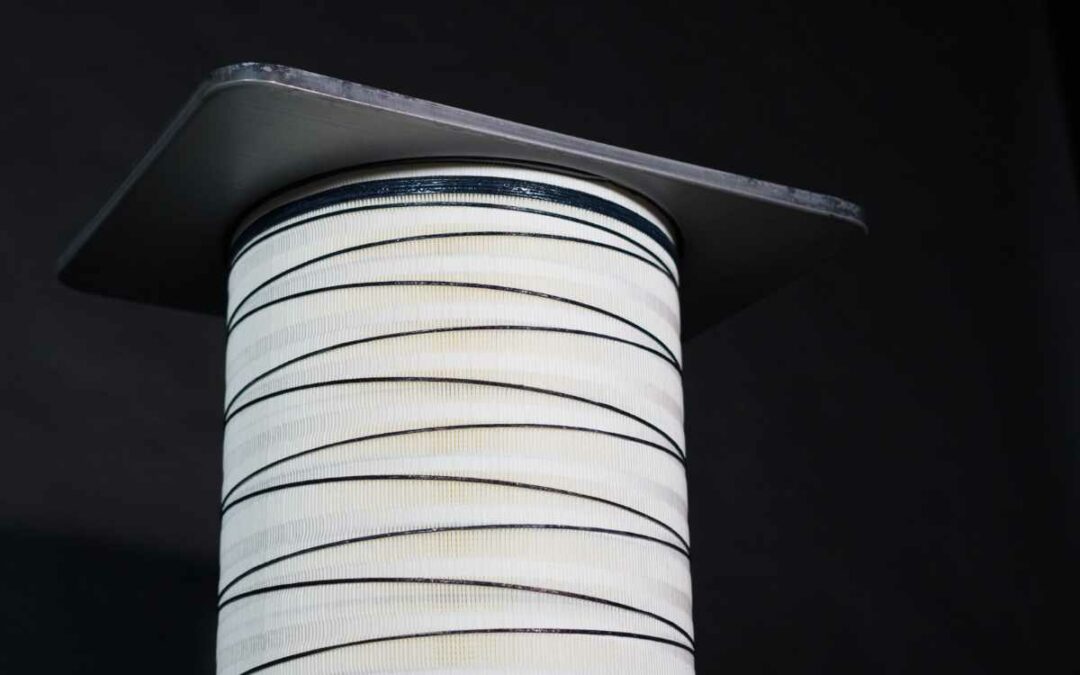
by Erin Long | Nov 26, 2024 | Uncategorized
The expected lifespan of dust collector filters is one of the most common questions in the air filtration industry. Unfortunately, there is no one-size-fits-all answer to how long these filters last because their longevity depends on several variables. These include the type of dust being filtered, air volume, and system maintenance practices. Understanding these factors can help you maximize the life of your filters and ensure optimal system performance.
The Impact of Dust Type
One of the primary factors affecting dust collector filter life is the type of dust your system handles. Dust with abrasive or aggressive properties can wear down filters more quickly. While lighter, less damaging particulates tend to allow for longer use. For example, filters handling fine sawdust in a woodworking shop may outlast those dealing with similar machines in a metal shop. Knowing the nature of your dust is key to selecting the right filter and anticipating its lifespan.
Air Volume and Its Effect on Filters
Air volume also plays a significant role in determining filter longevity. A higher air volume can lead to faster accumulation of dust on the filter surface. This not only increases the frequency of filter cleaning but can also result in quicker wear and tear. Ensuring that your dust collection system is sized correctly for your needs can mitigate this issue. It prevents the system from working harder than necessary.
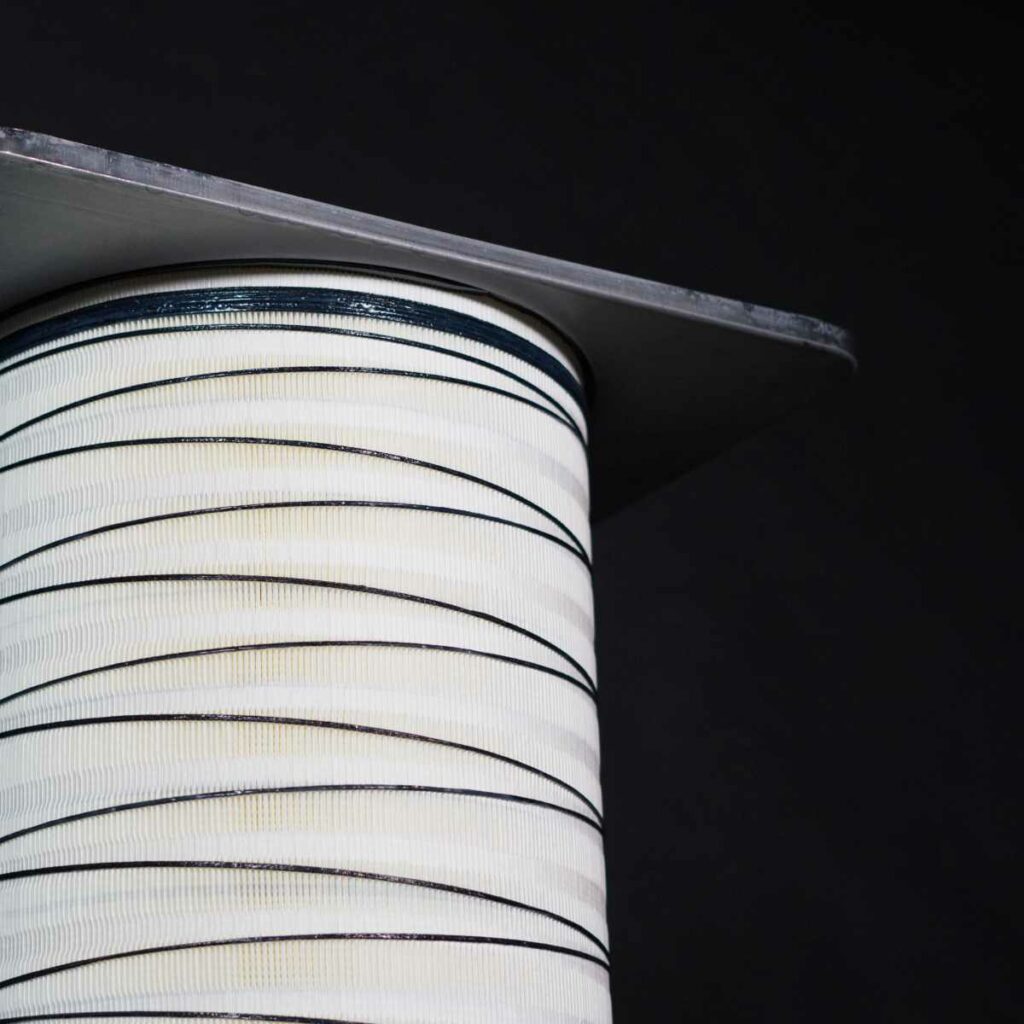 Maintenance: The Unsung Hero of Filter Longevity
Maintenance: The Unsung Hero of Filter Longevity
Regular preventative maintenance is critical for getting the most life out of your filters. Neglecting maintenance tasks like inspecting for water leaks in ductwork and ensuring proper system airflow can significantly reduce the lifespan of your filters. Over time, dust accumulation and system inefficiencies can lead to higher stress on the filters, accelerating their deterioration.
One of the best practices for maintaining filters is using a differential pressure gauge to monitor the pressure drop across the filters. It can be either electronic or analog. Most dust collectors will come with a pressure gauge as a standard part. This is the most reliable indicator of when a filter has reached the end of its lifecycle. When the pressure drop exceeds 5 inches of water column, it’s time to replace the filters. This is regardless of how long they’ve been in use. Relying on this metric as opposed to a time-based parameter ensures you do not prematurely discard or use filters beyond their effective lifespan.
So, How Long Do They Last?
Given the wide range of applications and operating conditions, dust collector filters can last anywhere from a couple of months to a couple years. Systems filtering abrasive dust in high volumes with minimal maintenance will see shorter filter life. On the other hand, filters in systems handling less aggressive dust, paired with diligent maintenance, can last significantly longer.
Maximizing Dust Collector Filter Life
To extend the life of your filters, invest in regular maintenance, monitor pressure drop consistently, and tailor your dust collection system to your specific application. We suggest using a VFD (variable frequency drive) to automatically adjust airflow over the life of the filters. This VFD starts the fan at a slower speed when the filters are new and increases power as the filters build a dust cake and pressure drop. The second benefit to the VFD is an overall decrease in power consumption. These steps not only optimize filter performance but also reduce operational costs over time. By paying attention to these factors, you can make informed decisions and ensure your dust collection system operates efficiently for as long as possible.
A dust collection professional can help ensure that you see optimal filter life. The team at Imperial Systems will design a system with proper air volume, suggest the best media for your application, and even provide regular dust collector maintenance.
Read more
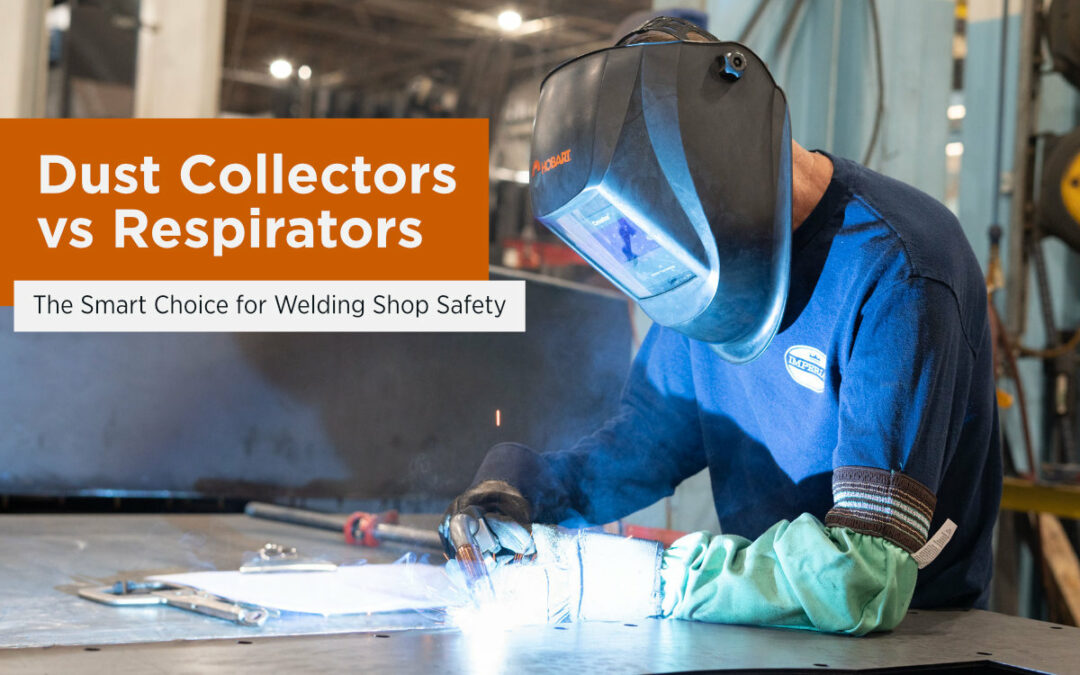
by Erin Long | Aug 23, 2024 | Uncategorized
In a welding shop, maintaining a safe and healthy work environment is a top priority. Welding generates harmful fumes and particulates, which can pose significant health risks to employees if not properly controlled. To mitigate these risks, some shops rely on respirators. These respirators may be a part of the welding helmet. They may also be a separate PPE device to wear under the helmet. Other companies may invest in comprehensive dust collection systems. While both options offer protection, a dust collection system is the superior choice for several key reasons.
Comprehensive Air Quality Control, Unlike Welding Respirators
Welding respirators provide individual protection by filtering harmful fumes and particulates directly at the source. However, they limit coverage to the welder wearing the device, exposing others in the shop. This is similar to fume arms which capture fumes at the source but are often cumbersome to move and only protect the person working directly beneath them.
A dust collection system means that even employees who aren’t wearing respirators, such as those performing other tasks nearby, are protected from exposure to hazardous air contaminants. The overall air quality in the shop improves, leading to a safer work environment for everyone.
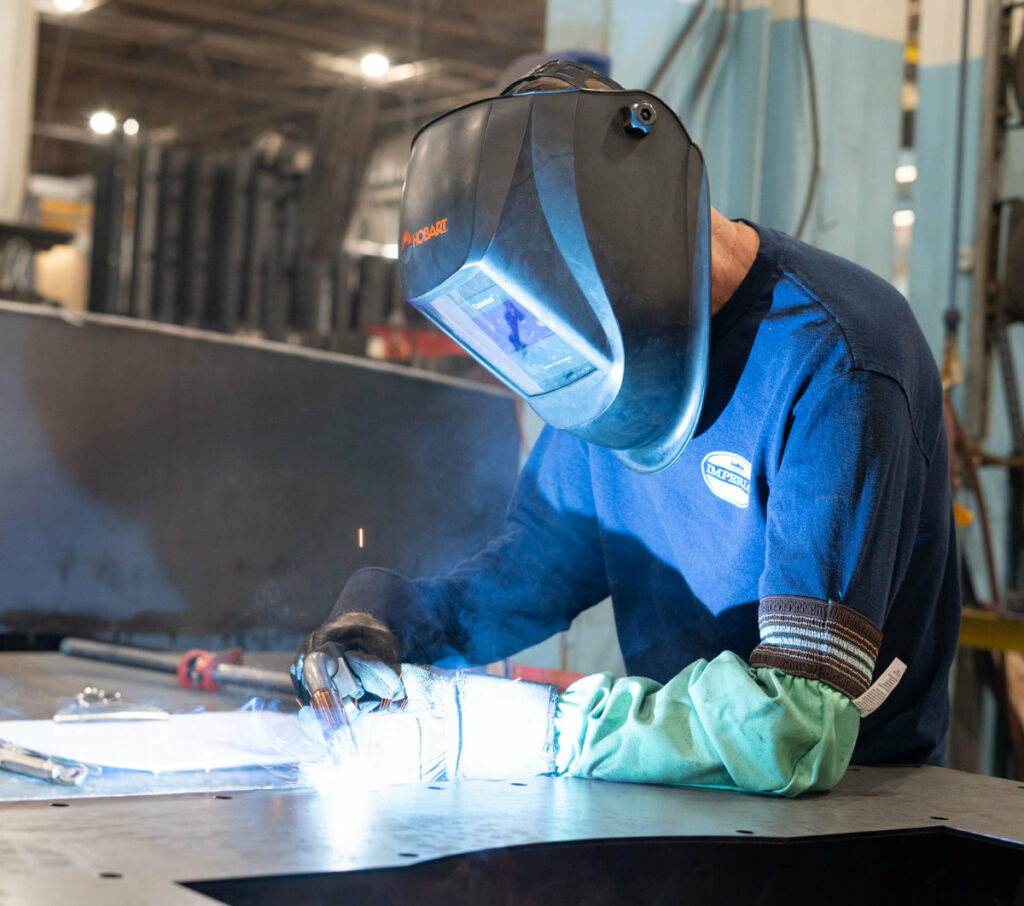 Consistent Protection Across the Workspace
Consistent Protection Across the Workspace
Welding respirators are designed to protect the wearer by filtering the air they breathe. However, the effectiveness of these devices can vary depending on how well they fit, filter change frequency, and whether the wearer is using a mask consistently.
However, a dust collection system operates continuously, ensuring consistent protection across the workspace. It doesn’t rely on individual usage habits or require regular maintenance from each employee. Properly maintaining the system provides reliable, ongoing protection against airborne contaminants. This reduces the likelihood of employee exposure and potential health issues.
Enhanced Productivity and Comfort
Wearing a welding respirator can be cumbersome and uncomfortable, particularly during long work shifts. The added weight and bulk of the filtration unit can cause fatigue, reducing productivity and increasing the likelihood of mistakes. Employees may also be tempted to remove their masks for brief periods, exposing themselves to harmful fumes.
In contrast, a dust collection system improves comfort and productivity by keeping the air clean without requiring any additional gear. Employees can work more comfortably and efficiently, knowing that the air they breathe is safe, without the need for heavy, restrictive equipment. This leads to fewer interruptions, higher productivity, and a more pleasant work environment overall.
Long-Term Cost Savings Over Welding Respirators
While respirators may seem like a cost-effective solution in the short term, they can become expensive over time. Filters need to be replaced regularly, and the devices themselves may need frequent maintenance or replacement. Additionally, the potential costs associated with employee health issues due to inadequate air quality control can be significant.
A dust collection system, although it requires a larger initial investment, offers long-term cost savings. It reduces the need for individual protective equipment, lowers the risk of health-related expenses, and extends the lifespan of tools and equipment by minimizing exposure to corrosive fumes and dust. Over time, the system pays for itself through improved efficiency, reduced maintenance costs, and a healthier workforce.
While welding respirators provide a level of individual protection, they fall short when compared to the comprehensive benefits of a dust collection system. A dust collector not only improves air quality for the entire shop but also enhances productivity, comfort, and long-term cost savings. For any welding shop serious about safety and efficiency, investing in a dust collection system is the clear and superior choice. Reach out to an Imperial Systems representative to discuss the best welding filtration solution for your facility.
Read more

by Erin Long | Jul 18, 2024 | Uncategorized
In industrial settings, dust collection systems are essential to maintain compliance with regulations. But they also offer substantial cost-saving benefits. Implementing an effective air filtration unit can lead to reduced downtime, improved product quality, and enhanced worker safety, ultimately translating into significant financial savings.

Reduced Downtime
One of the most immediate and tangible benefits of dust collection systems is the reduction in downtime. Industrial processes that generate large amounts of dust and particulates often suffer from frequent machinery breakdowns and maintenance issues. Dust accumulation can clog machinery, reduce efficiency, and lead to unexpected breakdowns. By capturing dust at the source, dust collection systems prevent these issues, ensuring that machinery operates smoothly and efficiently.
- Extended Equipment Life: Dust can cause wear and tear on machinery. Consequently, this leads to more frequent repairs and replacements. Air filtration units benefit the operational life of the equipment. They do so by keeping it cleaner and reducing the abrasive effects of dust particles.
- Reduced Maintenance Costs: Frequent maintenance is not only costly but also time-consuming. However, by minimizing dust accumulation, dust filtration systems reduce the need for regular maintenance. As a result, this lowers labor costs and allows maintenance staff to focus on other, more critical tasks.
- Increased Operational Efficiency: Clean machinery operates more efficiently. Dust collection systems ensure that machines function at their optimal capacity. This reduces the risk of slowdowns and ensures consistent production rates. Therefore, the increased efficiency translates directly into higher productivity and lower operational costs.
Improved Product Quality
Dust can significantly impact product quality, especially in industries where precision and cleanliness are paramount. Contaminants can certainly lead to defects, paint blemishes, rework, and even product recalls. All of these are costly and also detrimental to a company’s reputation. Consider these benefits:
- Enhanced Product Consistency: Dust contamination can cause variations in product quality. But by maintaining a clean production environment, dust collection systems help ensure that products meet consistent quality standards, reducing the risk of defects and improving customer satisfaction and loyalty
- Reduced Waste and Rework: Defective products often need to be reworked or discarded, leading to increased material costs and wasted labor. By preventing dust contamination, air filtration systems minimize the need for rework, reducing waste and saving resources.
- Compliance with Quality Standards: Many industries have stringent quality standards that must be met to maintain certifications and comply with customer requirements. Dust collection systems help ensure that production environments meet these standards. This avoids costly fines and ensures that products can be sold in regulated markets.
Additional Dust Collection Benefits
Beyond reducing downtime and improving product quality, dust collection systems offer several other cost-saving benefits:
- Enhanced Worker Safety and Health: Dust collection systems play a crucial role in protecting worker health by reducing airborne dust and improving air quality. Healthier employees mean fewer sick days, lower healthcare costs, and higher productivity.
- Energy Savings: Efficient dust collection systems can also contribute to energy savings. By maintaining clean air and preventing dust buildup, these systems help ensure that HVAC and ventilation systems operate more efficiently, reducing energy consumption and lowering utility costs.
- Regulatory Compliance: Non-compliance with environmental and safety regulations can result in hefty fines and legal fees. Dust collection systems help businesses stay compliant with regulations, avoiding these costly penalties and the possibility of a forced shutdown.
Investing in a dust collection system is not just about meeting regulatory requirements. It’s also a strategic decision that offers significant cost-saving benefits. By reducing downtime, improving product quality, and enhancing worker safety, dust collection systems help businesses operate more efficiently and profitably. Furthermore, the initial investment in a dust collection system is quickly offset by the long-term savings and operational improvements it provides, making it a wise choice for any industrial setting.
Read more
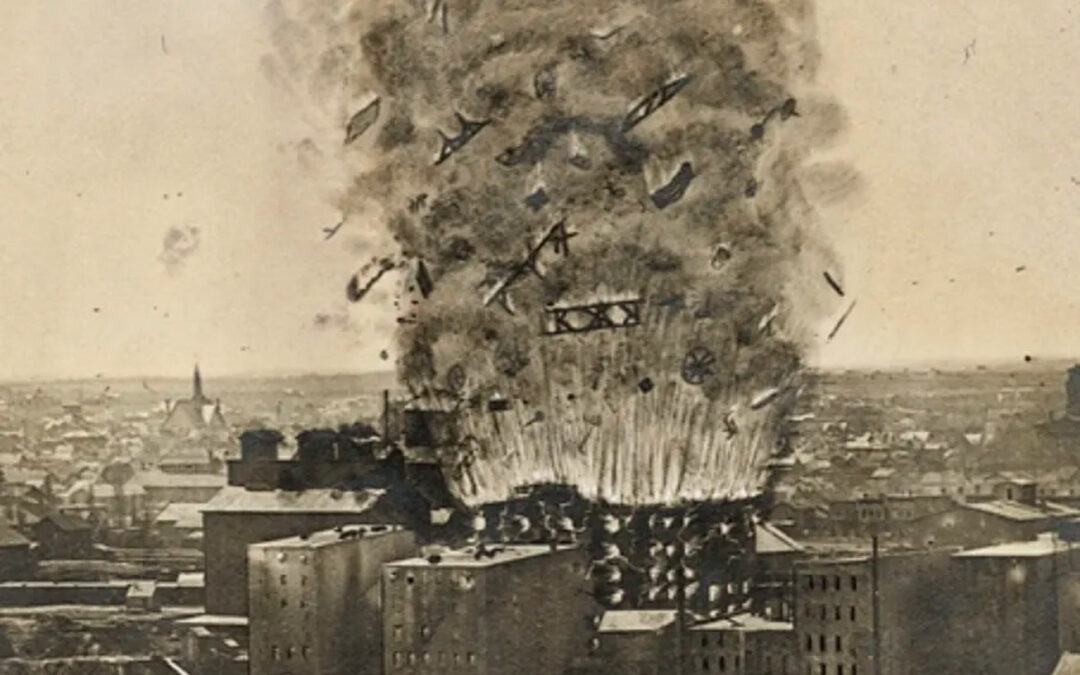
by Erin Long | Jun 25, 2024 | Uncategorized
Combustible dusts pose significant hazards in many industrial settings, and understanding the types of dust that can cause explosions is crucial for maintaining safety. In the dust collection industry, there are numerous types of combustible dusts that are frequently encountered. This blog post aims to provide an overview of some common combustible dusts, their sources, and the risks associated with them.
What is Combustible Dust?
Combustible dust consists of fine particles that, when suspended in air, can ignite and cause deflagrations. The dangers arise when these airborne dust particles encounter an ignition source, leading to a rapid combustion reaction. The presence of combustible dust in industries is a serious safety concern and has led to many tragic accidents.
Common Combustible Dust Types
1. Wood Dust
Sources: Woodworking industries such as sawmills, furniture manufacturing, and paper mills
Risks: Wood dust is highly flammable and can quickly accumulate in workspaces. Sawdust can create a significant explosion hazard if not effectively managed.
Example: Babine Forest Products, a sawmill in Burns Lake, British Columbia, experienced a dust explosion in 2012. The mill was in the process of installing an upgraded dust collection system. Prioritizing production over safety, they continued operations with an inadequate system during its upgrade. A buildup of wood dust near a conveyor belt motor was ignited by friction rotating belts and caused the explosion.
Source: Canadian Broadcasting Corporation
2. Metal Dust
Sources: Metalworking processes including grinding, cutting, and polishing; Common combustible dust from metals include aluminum, magnesium, and titanium
Risks: Metal dusts are highly explosive. Aluminum and magnesium dusts, for example, can cause violent explosions when ignited, often requiring dust collection with specific combustible dust accessories.
Example: In 2015, a fire caused by metal dust engulfed the Joseph Freedman Recycling Co., a metal recycling facility in Springfield, Massachusetts. The fire was caused by magnesium dust, which is extremely combustible. Due to the nature of the dust, and the high heat of the fire, the responders had no option but to let the fire dissipate on its own, leading to further loss at the facility.
Source: Hughes Environmental
3. Food and Grain Dust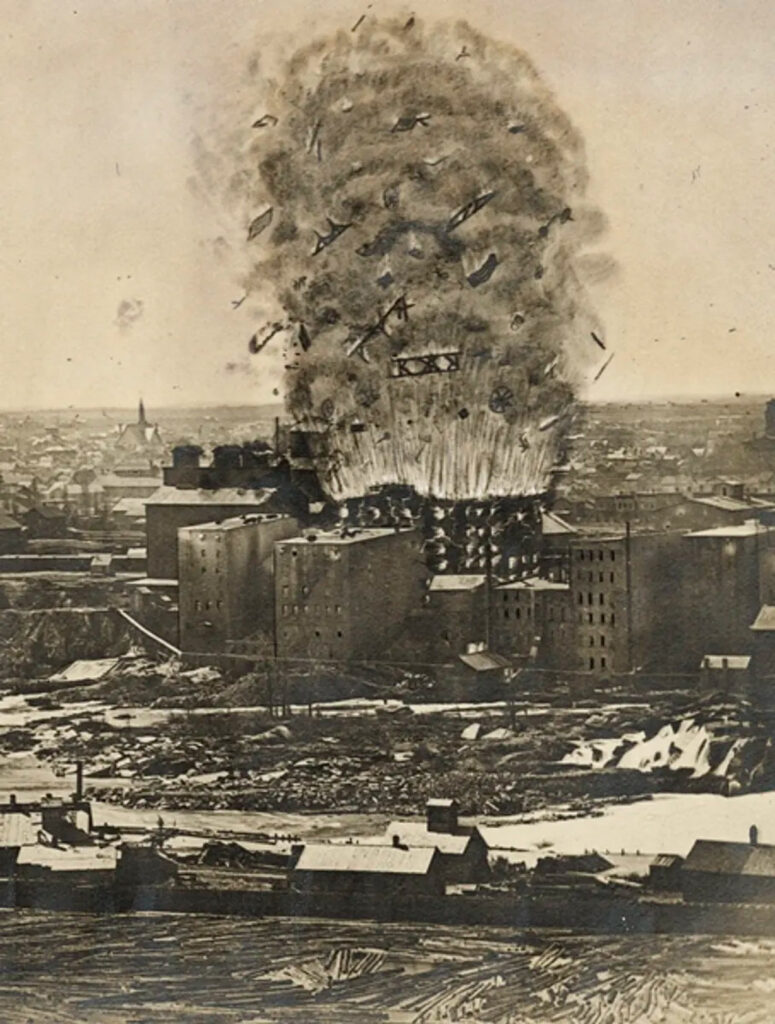
Sources: Agricultural industries, food processing plants, and bakeries. Examples include flour, sugar, grain, and spices.
Risks: Organic dusts from food and grains are very combustible. Historical records show that grain dust explosions are among the most common industrial explosions, often leading to devastating consequences.
Example: In 1878, a grain mill explosion occurred at Washburn A Mill in Minneapolis. This was one of the largest mills in the US at the time and would grow into what is now General Mills. Flour dust suspended in the air ignited, and the mill exploded, leveling five additional mills and spreading flames across several city blocks.
Source: General Mills
4. Coal Dust
Sources: Mining operations and coal-fired power plants
Risks: Coal dust is highly explosive and has been the cause of many mining accidents. Proper ventilation and dust collection are critical in these environments to prevent coal dust explosions.
Example: Considered the deadliest coal mine accident in history, the Benxihu Colliery Disaster claimed the lives of over 1,500 miners. An explosion of gas and dust caused the 1942 tragedy. Authorities decided to seal the mine, cutting off the fire’s oxygen inside. This devastatingly trapped the miners inside where they were left to die.
Source: Asterra
5. Textile Dust
Sources: Textile manufacturing, especially during the processing of cotton, wool, and synthetic fibers
Risks: Dust from textile fibers can create a significant explosion risk in mills and production facilities.
Example: In 2001, an Italian wool factory experienced multiple dust incidents because of poor housekeeping. It took one spark to set ablaze dust that had been lying on nearby surfaces. From there, a series of secondary explosions rocked the facility. This incident killed three employees and caused considerable damage to the factory.
Source: United States Environmental Protection Agency
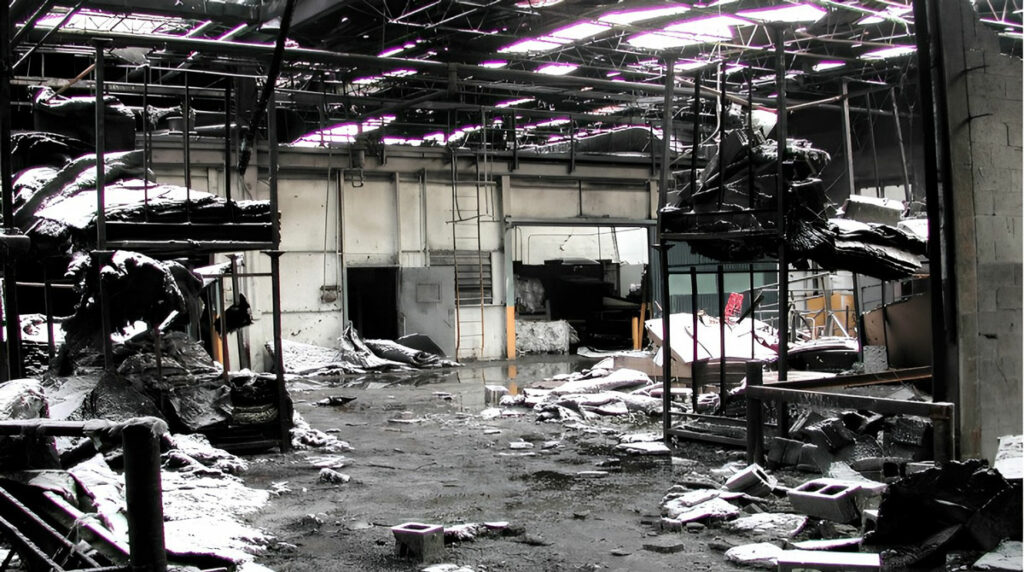 6. Plastic Dust
6. Plastic Dust
Sources: Plastic manufacturing and recycling plants
Risks: Plastic dust can accumulate and ignite under certain conditions. This dust is often produced during the cutting, grinding, and polishing of plastic materials.
Example: Tragedy struck the CTA Acoustics manufacturing plant in Corbin, Kentucky on February 20, 2003. An explosion and fire ripped through the facility, tragically killing seven workers. The plant produced fiberglass insulation for the automotive industry. The cause was determined as a buildup of resin dust in a production area. This dust, likely ignited by flames from a malfunctioning oven, fueled the explosion.
Source: Chemical Safety Board
Mitigating Hazards from Common Combustible Dusts
Understanding the risks associated with combustible dusts is the first step in mitigating potential hazards. Here are some key strategies for managing these risks:
1. Dust Collection Systems
- Design and Maintenance: Properly designed and maintained dust collection systems are essential. These systems should be designed to capture dust at its source and prevent it from accumulating in the work environment.
- Explosion Protection: Implement explosion protection systems such as explosion vents, suppression systems, and isolation devices to protect against dust explosions.
2. Housekeeping Practices
- Regular Cleaning: Establish and maintain a rigorous cleaning schedule to prevent dust buildup on surfaces, equipment, and floors.
- Proper Disposal: Safely dispose of collected dust to prevent re-suspension and accumulation.
3. Ignition Source Control
- Control Sources: Identify and control potential ignition sources, including sparks, static electricity, hot surfaces, and open flames.
- Electrical Equipment: Use appropriately rated electrical equipment in areas where combustible dust is present.
4. Training and Awareness
- Employee Training: Train employees on the hazards of combustible dust and the proper use of dust collection and explosion protection systems.
- Safety Protocols: Develop and enforce safety protocols to ensure consistent and safe handling of combustible dust.
Combustible dusts present significant hazards in various industrial settings, but with proper understanding, planning, and implementation of safety measures, these risks can be effectively managed. Ensuring the safety of workers and facilities requires a comprehensive approach, including effective dust collection systems, control of ignition sources, and ongoing employee training. By recognizing and addressing the dangers of combustible dust, industries can maintain safer and more efficient operations.
While this list highlights the more common combustible dusts, it is by no means comprehensive. Dusts produced or present in a facility should be tested. This will determine the risk for flammability or combustibility with a particular dust.
If your dust has never been tested, or if your process has changed since the last time it was tested, it is imperative to do so. The team at Imperial Systems will facilitate your dust test and help you understand the results. Contact us at 800.918.3013 or aftermarketsales@isystemsweb.com.
Read more
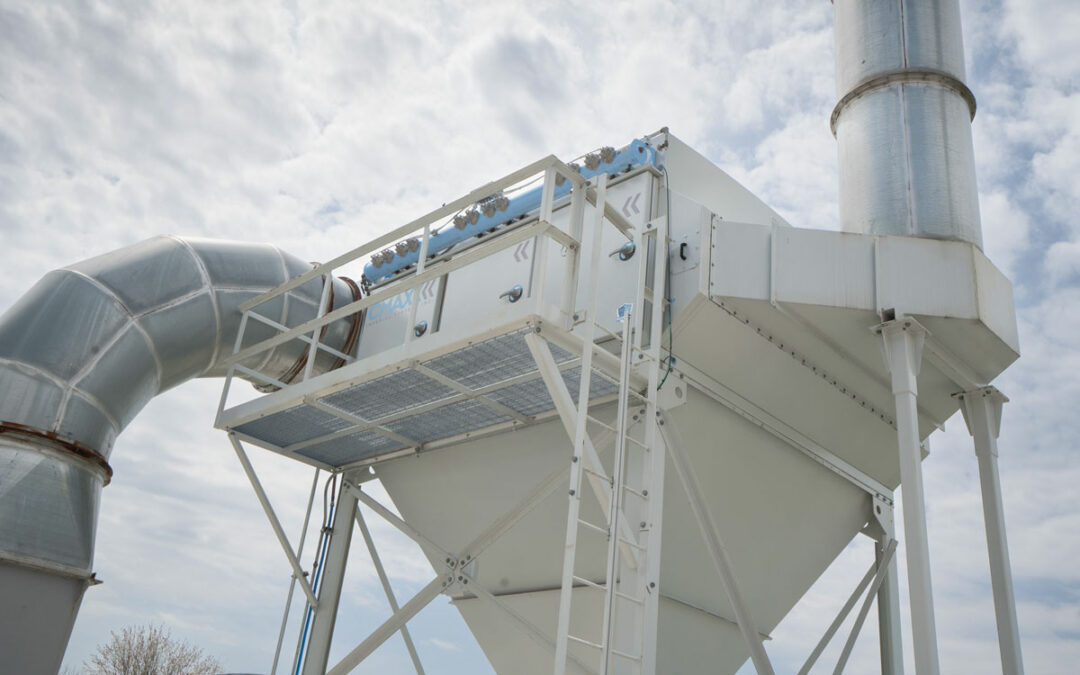
by Erin Long | Jun 20, 2024 | Uncategorized
Effective dust and fume collectors, also known as air filtration systems, are crucial for ensuring employee safety, safeguarding equipment, and complying with safety, health, and environmental regulations in industrial environments. Planning and purchasing the right industrial dust and fume collector can be a complex process. To help navigate this task, here are some key considerations to keep in mind:
1. Understand Your Needs
Before purchasing a dust and fume collector, it is essential to understand your specific requirements. Consider factors such as the type and volume of dust and fumes generated in your facility, the size of the area to be covered, and any regulatory requirements that need to be met. Conducting a thorough assessment of your needs will help you choose the most suitable collector for your application.
2. Types of Dust Collectors
There are several types of industrial dust and fume collectors available, each with its own advantages and limitations. Common types include baghouse collectors, cartridge collectors, cyclone collectors, and electrostatic precipitators. There are pros and cons to each of these types of collectors. So, research online or ask an expert to help you determine which one is best suited to your needs.
3. Consider Airflow and Filtration Efficiency
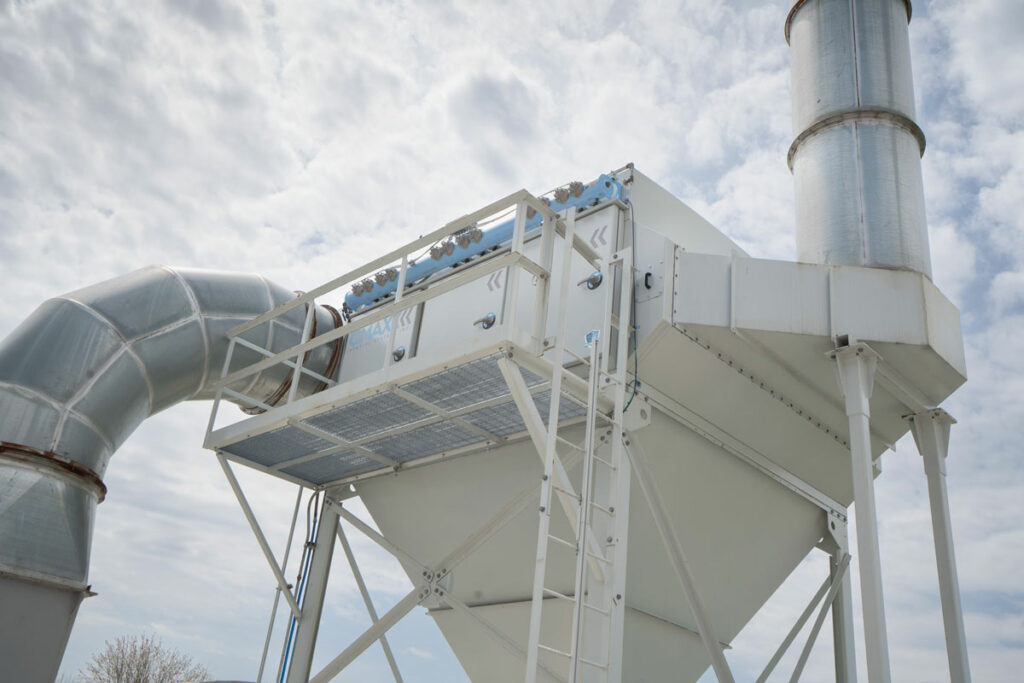 Airflow and filtration efficiency are critical factors to consider when selecting a dust collector. The collector must be able to handle the volume of air and contaminants produced in your facility while maintaining high filtration efficiency to ensure clean air output. Therefore, be sure to choose a collector with the appropriate airflow capacity and filtration efficiency for your application and facility.
Airflow and filtration efficiency are critical factors to consider when selecting a dust collector. The collector must be able to handle the volume of air and contaminants produced in your facility while maintaining high filtration efficiency to ensure clean air output. Therefore, be sure to choose a collector with the appropriate airflow capacity and filtration efficiency for your application and facility.
4. Evaluate Maintenance Requirements
Regular maintenance is also essential for ensuring the optimal performance and longevity of your air filtration equipment. Consider factors such as filter replacement frequency, ease of access for maintenance tasks, and the availability of replacement parts when evaluating different dust collector options. Choosing a collector with minimal maintenance requirements can help minimize downtime and operating costs.
5. Energy Efficiency
Energy consumption is another crucial consideration when selecting a dust and fume collector. Look for features such as variable frequency drives (VFDs) and optimized airflow designs. These can help reduce energy consumption and operating costs over time. Investing in an optimized, energy-efficient collector can lead to significant long-term savings.
6. Compliance with Regulations
Ensure that the dust and fume collector you choose complies with relevant industry regulations and standards. This includes those set by organizations such as OSHA, NFPA, and the EPA. There may also be local authorities in your area with unique regulations. Compliance with these regulations is essential for maintaining a safe and healthy work environment and avoiding potential fines or penalties.
7. Budget Considerations
Finally, consider your budget when planning and purchasing an industrial dust and fume collector. It is important to weigh the upfront costs just as much as ongoing maintenance expenses and long-term operating costs of different collector options to find the most cost-effective solution for your facility.
Planning and purchasing an industrial dust and fume collector requires careful consideration of a range of factors. By taking these key considerations into account, you can choose the right collector for your application and ensure a safe, healthy, and efficient work environment for your employees. Consulting a dust collection expert who is familiar with system design for various applications as well as regulations and standards can go a long way.
Partnering with Imperial Systems can provide valuable support and guidance throughout the process of selecting a dust collection system. With our extensive experience and expertise in the field, we can help you assess your specific needs, recommend the most suitable collector for your application, and ensure compliance with industry regulations. Our dedication to quality craftsmanship and customer service means you can trust that you are investing in a reliable and high-performance dust collection solution. By partnering with Imperial Systems, you can gain peace of mind knowing that your dust collection system is in capable hands, allowing you to focus on running your facility efficiently and safely.
Read more

 Maintenance: The Unsung Hero of Filter Longevity
Maintenance: The Unsung Hero of Filter Longevity 







